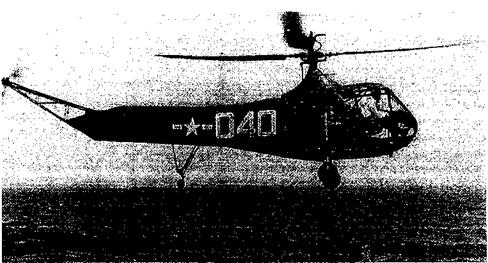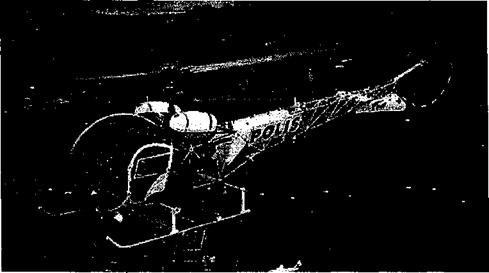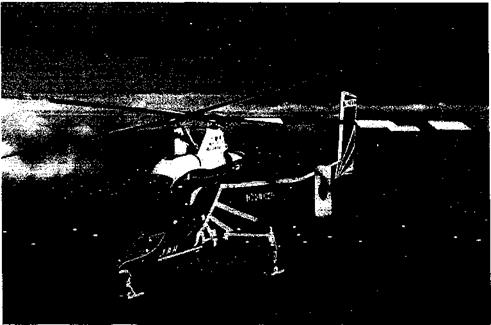Toward Mass Production
The immediate post-WW2 era is marked by a significant increase in the number of prototype helicopters, many of which went into scale production. It has already been mentioned how the development of the engine was an enabling technology for the helicopter, with rapid advancements in power output and reductions in engine weight taking place during the war. This was accompanied by simultaneous reductions in the empty airframe weight of the helicopter through the use of high-strength, lightweight construction materials such as aluminum and lighter alloys of steel, as well as developments in aerodynamics, flight control effectiveness and improved flight stability. This period represents a concrescence of various technologies and the onset of commercial success for the helicopter. This time period also coincides with the postwar economic recovery, which led to the maturation of helicopter technology and mass production, with increasing use of the helicopter in both military and civilian roles.
Before long, Sikorsky had refined his VS-300 machine and by 1941 he had started production of the R-4 (Fig. 1.26). In 1943 Sikorsky developed the R-6, which, although still only a two-seater helicopter, was larger and had notably better performance than the R-4. The R-6 was produced in substantial numbers and some of them saw action in the Pacific
|
Figure 1.26 The Sikorsky R-4B (Navy/Coast Guard HNS-1) being flown by famed helicopter pilot Frank Erickson, circa 1945. |
during WW2. In 1946 Westland Helicopters in Britain obtained a license to build variants of the Sikorsky machines, the first being designated as the WS-51A after the S-51, which was a civilian development of the R-5D. This period was the start of a long relationship between the two companies, which continued for decades. Westland already had a history as a successful fixed-wing manufacturer and, as previously mentioned, they had briefly flirted with autogiros in the 1930s, but the company decided to specialize in helicopters in 1946 [see Mondey (1982)]. After significantly reengineering the Sikorsky machine, Westland called the aircraft the Dragonfly. The Widgeon later followed and this was a very modem looking and powerful version of the Dragonfly with a larger passenger cabin. However, it was the Bristol Aircraft Company that was to build the first fully British designed helicopter, with the Bristol-171 Sycamore (Fig. 1.27) taking to first flight in 1947.
|
Figure 1.27 In 1947, the Bristol 171 Sycamore was Britain’s first certified helicopter. (Westland Helicopters photo.) |
Design refinements and material advancements led to lighter weight water-cooled engines, with cylinders arranged in two banks in the form of a “V.” These engines saw considerable development up to and through WW2, with power-to-weight ratios of about
0. 75 hp/lb (1.23 kW/kg) in normally aspirated form and up to ratios of unity in supercharged form (see Fig. 1.17, shown previously). Air-cooled radial engines too underwent significant developments during this period. In 1925, the radial engine had a power-to-weight ratio of about 0.5 hp/lb (0.82 kW/kg), but ratios of 0.9 hp/lb (1.48 kW/kg) were more commonplace by the mid-1930s. It was engines in this class that were to give the helicopter the performance that led to its first success as a practical and useful flight vehicle, although
nbll ufifliAiit пглКІотс T7or1; Inali/^rvntarc ІопЯаЯ Іл nfi 117a cfonrlorrl oimlonp nnti/pmlontc
51Ш uvh yyiLiiuui jjiuuivuu* і j uwiо iv/iiuL/u iv uuijlzjV отпиши Ull^lUUV ^/vn
turned vertically, which caused problems with oil fouling of the spark plugs. Also, because the engines had to operate at near to maximum rated power for nearly all of a flight, they had a far lower lifespan than was typical when the engine was used in airplanes. Cooling was also a serious concern, especially in hovering flight. WWII did see the development of purpose-built helicopter engines (derated, repositioned accessories, improved cooling and oil sumps, etc.) to overcome these challenges, but development delays prevented them from seeing much service until after the war. Simultaneous reductions in airframe weight that were brought about by advances in lighter materials saw very rapid improvements in overall performance and payload capability of the helicopter by the mid-1940s.
During 1942, the Cierva-Weir Company, prompted by the success of Sikorsky’s XR-4, proposed a relatively large single rotor machine called the W-9, which was unique in its use of jet thrust to counteract rotor torque reaction – see Everett-Heath (1986). The rotor lacked any collective pitch control and rotor thrust was controlled through changing rotor speed as in the pre-WW2 Weir W-5 and W-6 models. The machine demonstrated several
pAt* tllA АГО 1ПЛІ11/І1ПА Г/4гЛИІ1 АОІ 11 Г КаАПІА/^ fluT^f АЛТі^ГЛІР T-T АТТ7АЛ ТОГ*
i^uinivaji ішшуаишю iui uiv ua, uiviuuuig ujuiaunv/anj ukjkjoіл*лд wuuvio. iivwvyvjl, the W-9 crashed during a test flight in 1946 and the project was subsequently abandoned. The Weir and Cierva companies later went on to design the W-11 Air-Horse, which was a unorthodox three-rotor helicopter with considerable lifting capability – see Everett-Heath
(1986) and Leishman (2003). While successful, this machine also crashed during a test flight and further work was terminated. The final helicopter of the Cierva-Weir line was the W-14 Skeeter, which was a small two-seater training helicopter designed in 1948. This machine saw a production run through 1960, and was used by the British and German armed forces.
One measure of the lifting efficiency of a helicopter is its power loading, which is defined as the ratio of the weight of the machine to the power required for hovering flight (see Chapter 2). This can be further qualified by defining the power as that delivered to the rotor shaft and not the installed engine power. The higher the power loading, therefore, the more efficient the machine as a vertical lifter and hoverer. Figure 1.28 shows power loading as a function of year of helicopter development. Several points are worthy of note here.
TJirct ttAfina tliot aorlxr kalir*Anfarc Viosl о ralofurobr Vtmti гл«;аг іаоИішт о гаспіі г*лгіЬ*ог7 і 1X01} iivuw uiut wcuxj livuvvj^tvio iiuu u ivmuYVij m^ii pvtvva. rvuuiugf u – xv’uuxt wiiu. ш.у
to initial expectations, yet these machines were not successful other than making brief hops or hovers. This is because they were overweight (high empty weight fraction) and underpowered, and also because the rotors had poor aerodynamic efficiency. The point of initial “success” for the helicopter, which is about 1938-1940, represents the concrescence of engine, materials, and airframe construction technology, along with advances in the aerodynamic performance of the rotor. At this point, the values of power loading to enable basic hovering and forward flight with significant useful payload were first realized. This coincides with a significant increase in the number of prototype helicopters. Second, notice that there is a distinct “knee” in the curve in Fig. 1.28 in the late 1940s and early 1950s. This
Year of first development
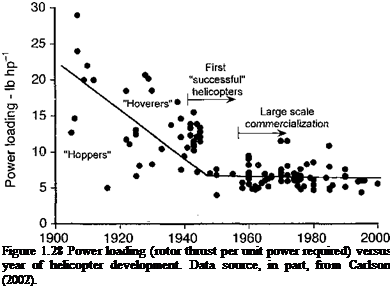 |
coincides with the postwar economic recovery, which led to the maturation of helicopter technology and mass production, with increasing use of the helicopter in both military and civilian roles. Finally, notice from Fig. 1.28 that after this period the values of power loading for later helicopters stay relatively constant at between 5 and 7 lb/hp (1.7 to 2.35 kg/kW), whereas one misht hav*1 tn «рр inrxp. asps in nnwe. r lnadinp as я result of further
О ^^ rw" ‘ О————- ————
technological advances and lightweight engines. While these advances have indeed taken place [e. g., Carlson (2002)], parallel increases in main rotor disk loading to reduce the size and cost of the helicopter have caused power loading values to stay relatively constant.
It is significant to note that while helicopters were becoming more and more successful, the development of the autogiro continued in Europe and the United States well into the 1950s. Considerable development work was undertaken by the Pitcairn [see Pitcairn (1930) and Smith (1985)] and Kellett aircraft companies in the United States. Harold Pitcairn patented many concepts in rotor blade design and rotor control, many of which were licensed and used by various helicopter manufacturers. The unfortunate timing of autogiro development, however, led to its limited success with the military. The US Navy considered the autogiro for shipborne use in submarine detection and convoy defense. Initial trials of the Pitcairn XOP-1 autogiro, however, were less than impressive, with the Navy citing poor range, insufficient payload capability and limited center of gravity travel. While later models of the autogiro had much improved capabilities, the Navy remained unconvinced. The. US Army later tested both the Kellett and Pitcairn machines in a variety of roles, including reconnaissance and battlefield observation. The low-speed loiter capability of the autogiro seemed particularly promising for artillery spotting roles, and the Army saw the autogiro as a promising start to a new class of aircraft. The Navy would continue to reject any rotating-wing aircraft concept out-of-hand (until ordered by Congress to desist in 1943) and did buy some autogiros built by Kellett. Other rotor design patents from the Weir and Cierva companies in Britain were transferred to the Pitcaim-Larsen Company (as it was later known) and then to the G&A (Gliders & Aircraft) Division of the Firestone Tire & Rubber Company. They subsequently built a small prototype helicopter, first flown in 1946, called the G&A XR-9, which was designed by Harold Pitcairn.
In Britain during the 1940s and 1950s, the autorotating rotor concept was pursued to some significant end by the Fairey Aviation Company. The Fairey Girodyne compound aircraft (or convertiplane) used a propeller set on the end of a stub wing to provide both propulsion and anti-torque – see Everett-Heath (1986). The Fairey Company went on to develop the Jet Girodyne in which the rotor system was driven by tip jets based on the von Doblhoff principle. This ultimately led to the Rotodyne, which was the world’s biggest gyroplane with a cabin big enough for forty passengers – see Hislop (1958) and the more detailed description Section 12.17. The aircraft set a world speed record for a convertiplane in 1959 before the project was canceled. Smaller single – and two-seat autogiros were later developed by various individuals and small companies for the private market.
Besides Igor Sikorsky, there were several other designers in the United States who were pioneering the helicopter during the 1940s. These included Arthur Young, Frank Piasecki, Stanley Hiller, and Charles Kaman. In the late 1930s, Arthur Young began a series of experiments with model helicopters that were ultimately to lead to the design of the renowned Bell Model 47 helicopter. After much research, Young invented the teetering rotor with a stabilizer bar; see Young (1948, 1979). This, bar had bob weights attached to each end and was directly linked to the rotor blades through the pitch control linkages. The idea was that if the rotor was disturbed in pitch or roll, the gyroscopic inertia of the bar could be used to introduce a compensating cyclic pitch into the main rotor system, increasing the effective damping to disturbances and giving stability to the rotor system – see also Kelly (1954).
The prototype Bell Model 30 was built in 1942 and had a single main teetering rotor with Young’s stabilizer bar. The first untethered flights took place in 1943 and the machine was soon flying at speeds in excess of 70 mph (112 kph). The Bell Model 30 design led to the famous Bell Model 47 (Fig. 1.29), which was the world’s first commercially certified helicopter. During its nearly thirty-year manufacturing period over 5,000 were produced in the United States alone and many were also license built in more than twenty other countries. Tipton (1989), Brown (1995), and Spenser (1999) give a good historical overview of the
|
Figure 1.29 A version of the Bell Model 47, which was the world’s first commercially certified helicopter. (By permission of Bell Helicopter Textron.) |
Bell machines. Schneider (1995) gives a short biography of Arthur Young and his novel teetering rotor design.
In 1943, Frank Piasecki designed and flew a small helicopter that was called the PV-
2. Piasecki, who had previously worked for Platt-LePage, developed the fourth helicopter to fly in free-flight in the United States after the Platt-LePage XR-1 and Sikorsky’s VS-300, and the successful XR-4. Piasecki’s company was to develop the overlapping tandem rotor configuration, a concept patented by Gish Jovanovich and demonstrated as early as 1944. Piasecki immediately turned to larger helicopters and in 1945 his company, the P-V Engineering Forum, built a tandem rotor helicopter called the PV-3 Dogship. Details are given by The Piasecki Corporation (1967) and Spenser (1999). This aircraft was popularly called the “Flying Banana” because of its distinctive curved fuselage shape. Despite its unfortunate nickname, however, the aircraft was very successful and larger and more powerful versions quickly followed, including the H-16 and H-21 “Workhorse” models of 1952, which were built by the Piasecki Corporation. The Piasecki Corporation became the Vertol Company who developed the Model 107 (CH-46) in 1956 and a larger military tandem rotor model, the CH-47 (Fig. 1.30), was to be the mainstay product for the company. The Vertol Company finally became Boeing Helicopters. An overview of the Boeing-Vertol machines produced up to the mid-1970s is given by Grina (1975). In the late 1980s, the company produced a demonstrator of an advanced technology tandem rotor helicopter called the Model 360. The only other company in the United States to build a tandem helicopter design was Bell, who manufactured the unsuccessful HSL-1 during the 1950s.8 In 1998, Boeing announced the launch of the CH-47F and the CH-47SD “Super-D” Chinook, with the latest model being the MH-47G. See The Boeing Company (2005).
The British company, Bristol Helicopters, had designed and built a single rotor helicopter and later tandem helicopter during the late 1940s under the leadership of the helicopter
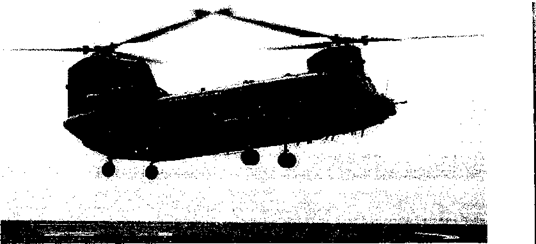 |
The failure of the HSL-1 was partly responsible for the amazing success of Sikorsky’s S-58.
pioneer Raoul Hafner-see Hobbs (1984) andEverett-Heath (1986). The Type-171 Sycamore (Fig. 1.27) was the first British helicopter to be certified for civil use – see Hafner (1949) and Dowling (1992) for details. The Bristol Type-173 had a long, slim fuselage with two three-bladed rotors at each end, similar to the Piasecki machines. The Bristol Type-192 Belvedere was an improved tandem rotor design, which followed in 1958 with more powerful turboshaft engines. However, the Bristol company found it difficult to compete with helicopters being produced by Sikorsky and Westland, and more limited numbers of their helicopters were produced.
In the United. States, Charles Kaman adopted Anton Flettner’s synchropter rotor design. One of Kaman’s innovations was the use of torsionally compliant solid spar spruce rotor blades with servo-flaps. The servo-flaps were mounted at the three-quarter rotor radius, some distance behind the elastic axis of the blade. When these flaps were deflected cyclically, the aerodynamic moments caused the blades to twist, changing their angle of attack and thus introducing a cyclic pitch rotor control capability – a system first used by d’ Ascanio (Fig. 1.20). The first Kaman helicopter, the K-125A, flew in 1947. By the 1950s the turboshaft engine had almost entirely replaced the reciprocating engine in most aircraft, including the helicopter. The Kaman K-225, became the first helicopter to fly powered by a turboshaft engine. A family of larger machines, known as the H-43 Huskie and its derivatives, were produced through 1964. While Kaman reverted to conventional single rotor helicopter designs in the later 1950s, the servo-flap concept continued to be a trademark of all of the Kaman helicopters. The H-2 Seasprite first flew in 1959 and has been produced in considerable numbers. Kaman has recently returned to the synchropter concept with the design of the К-Max (Fig. 1.31), which first flew in 1991. See Kaman Aircraft Corporation (2005) for further details of their helicopter lineage.
|
Figure 1.31 A modem synchropter design, the Kaman К-Max. (By permission of Kaman Aircraft Corporation.) |
Stanley Hiller is another American pioneer in the development of the modem helicopter – see Straubel (1964) and Spenser (1992, 1999). Hiller built several helicopter prototypes,

 |
including the coaxial ХЫ-44, which flew successfully in 194ч-. /iuiougn пшеї pmsueu
other coaxial and tip-jet driven rotor machines, his later helicopters used a conventional main rotor and tail rotor configuration. His main breakthrough was the development of the “Rotor-Matic” main rotor design, where the cyclic pitch controls were connected to a set of small auxiliary blades set at 90° to the main rotor blades. These auxiliary blades or “paddles” worked in a similar manner to the Bell stabilizer bar, providing compensating cyclic pitch inputs and effecting damping in pitch and roll helping to augment the hovering stability of the machine. The basic theory of both stabilizing concepts are nicely explained by Sissingh (1948). It is significant to note that both Hiller and Young designed stability – producing mechanisms for their helicopters, whereas the Sikorsky machines had none and so they had a reputation for being harder to fly. While the Hiller machines are probably less well known than those of Sikorsky or Bell, the Hiller Company went on to build thousands of helicopters, including the 360 model (Fig. 1.32) and its further evolutions – the UH-12A and H-23.











